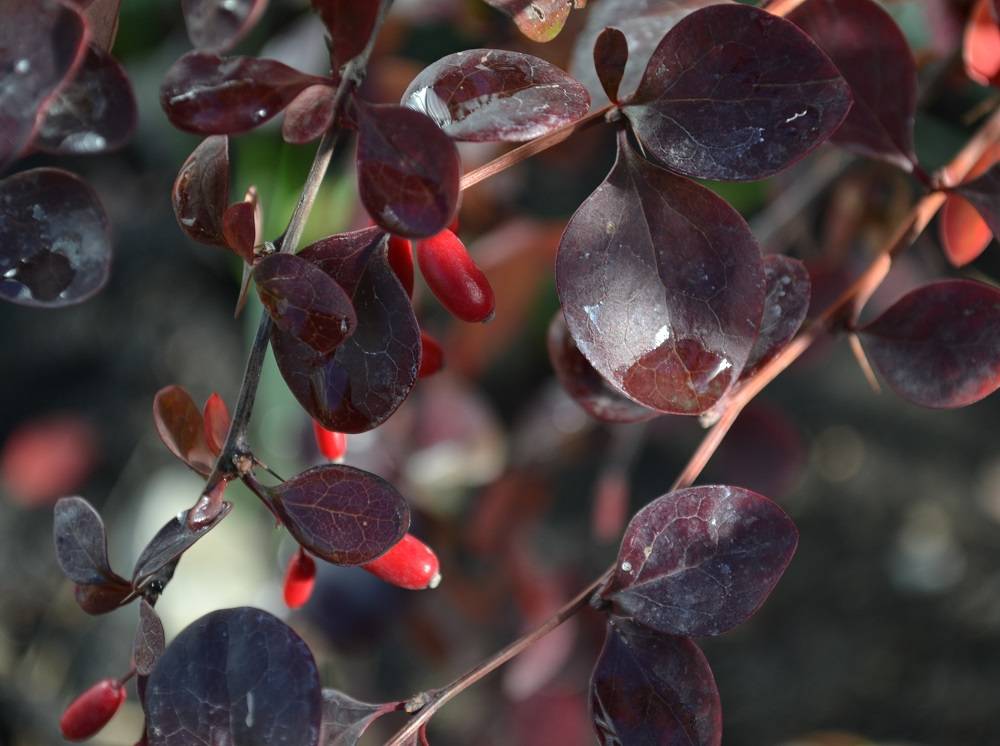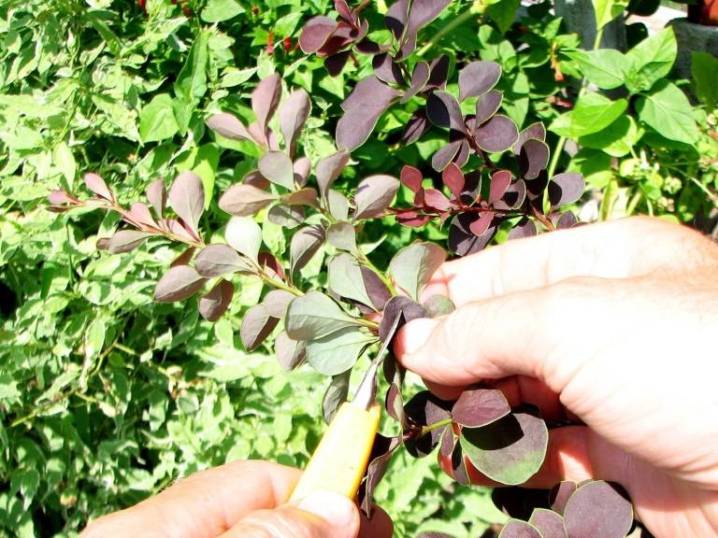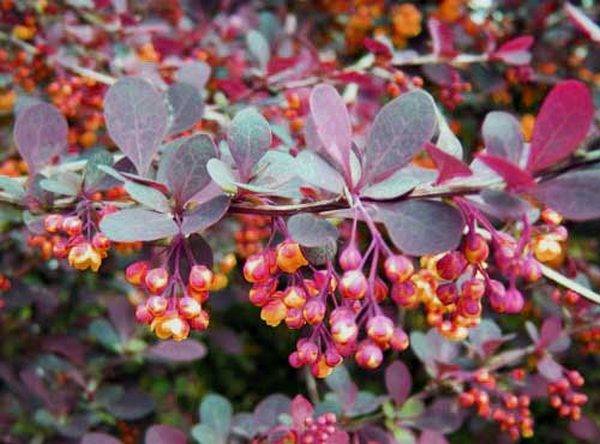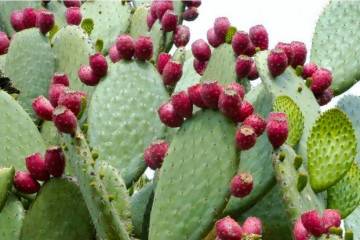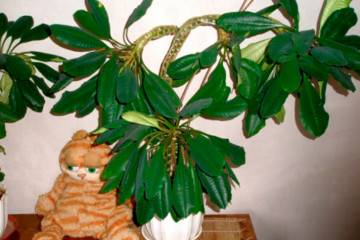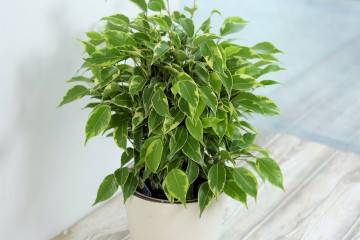Barberry Ottawa Superba - description and care
Content:
Barberry Ottawensis Superba (Berberis Ottawensis Superba) obtained by crossing an ordinary variety and barberry Thunberg. Officially, barberry Superba and its description were entered into the State Register in 1889. The variety was named in honor of the city of Ottawa. In Russia, it is known as the Superba barberry. Florists are used to create flower arrangements, hedges. Along with decorativeness, it also has healthy and tasty fruits.
Description of barberry Superba
Ottawa barberry Thunberg is a tall and deciduous shrub. Adults (8-10 years old) bushes sometimes grow up to 4 m. The annual growth is 35-40 cm. Thanks to the basal processes, the bush grows rapidly and in breadth. In young bushes, shoots grow strictly vertically, but with age, their length increases, and they begin to slope downward in an arc-like manner.
The dense crown is abundantly overgrown with dark purple oval leaves. The leaf plate grows up to 5 cm. In the summer months, the surface of the leaves casts a dark silver. Closer to winter, the foliage in some places acquires a deep burgundy color. There are large sharp thorns along the entire length of the shoot.
The foliage retains its colorfulness throughout the season. Neither rain, nor bright sun, nor shade affect decorativeness.
In early May, the bush is covered with red-yellow flowers, collected in 8-9 tassel inflorescences. Fragrant flowers serve as bait for honey insects. Flowering lasts about 3 weeks. Then the pollinated buds form an ovary. By the end of August, tart, sour berries ripen. The bright pink fruits are elongated and very firmly attached to the branch.
Planting a plant
The Canadian barberry should be planted during the dormant period. This is a very early spring or late autumn. The main condition is that the soil must warm up to 15 ° C. In autumn, the plant should be planted no later than 3-4 weeks before persistent frosts.
Planting from seeds
For further use in breeding, fully ripe fruits are selected. The bones, freed from the edible shell, are washed in a manganese solution and dried under natural conditions. A month before frost, the seeds are sown in a temporary nursery bed. Shoot picking is carried out in the spring after the appearance of 3-4 leaves. If the plantings are not very dense, then you should not disturb them.
They will grow on this bed for the next 2-3 years. Then they are transplanted to a permanent place.
For the winter, the nursery bed is covered with sawdust, peat, dry foliage or straw. You can put spruce branches on top.
For spring sowing, seeds need stratification within 4-5 months. To do this, they are mixed with river sand and sent to a refrigerator or cellar.
Planting seedlings in open ground
Experts recommend choosing an autumn planting. The place is sunny, but you can plant in partial shade. A prerequisite is the absence of groundwater and moisture stagnation. Weak drafts do not affect the development of the plant, although the bushes should be protected from strong winds.
The soil should be low in acidity. At pH-7, liming is required.
Given the size of the bush, the distance between plantings is maintained at 1.5-2 m.The depth and width of the pit for planting should be about 40 cm.The excavated soil is mixed with:
- turf;
- humus;
- peat;
- wood ash.
A seedling is installed in the finished hole, the roots are straightened along the bottom and covered with fertile soil. The root collar is not deepened. After planting, the plant is poured abundantly with warm, settled water.
How to care for barberry Superba
In order for the bush to please from early spring to late autumn, simple care is required. This is watering as needed, feeding and pruning.
If the place is initially chosen correctly, the bush will delight with bright foliage and tasty, healthy fruits for many years.
Watering
In dry weather, a bucket of water per week is enough for one bush. In rainy weather, watering is adjusted based on the circumstances. Warm, soft water is required. It is advisable to pour water at the root. After that, you will need to weed and loosen the soil of the root zone and level the mulch.
Top dressing
The first year the bush can not be fed, although the spring portion of urea will not hurt. It is also recommended to feed with nitrogen-containing fertilizers once every 4 years.
For successful wintering before the onset of cold weather, you need to add phosphate and potassium sulfate. Description and proportions are indicated on the fertilizer package.
During the flowering period, fertilizing with organic matter (manure, humus) is useful.
Pruning
The crown of the plant is formed annually It is safer to do this in the fall, a month before frost.
Starting from the second year, the bushes are shortened by half or one third. A rejuvenating haircut involves cutting branches at the root.
Pruning has the following goals:
- removal of old, sick and spoiled twigs;
- thinning the crown;
- anti-aging haircut.
Corrective pruning is allowed during the growing season, especially for hedges.
Reproduction methods
There are several ways to breed barberry. Young plants can be obtained:
- from seeds;
- by grafting;
- layering.
The last two methods give the best results. Seedlings are obtained only in half of the cases. Seed germination is only up to 45%. In addition, varietal qualities are not always preserved.
Cuttings are carried out in June, and the cuttings are buried in the spring. A one-year-old shoot will take root by autumn and form a new bush.
Diseases and pests
Superba is distinguished by its ability to secrete phytoncides, therefore it does not particularly succumb to diseases and pests. In exceptional cases (due to improper care), the Thunberg Superba barberry is attacked by them. The culture can suffer from aphids and moths. If slightly damaged, they can be collected by hand. However, to be sure, the bushes should be washed with a medicinal solution. It is prepared in this way:
- dissolve 400 g of ash in 5 liters of water;
- boil for about 40 minutes;
- filter the solution;
- add more water to make the volume 10 liters;
- fall asleep 50 g of grated laundry soap.
The procedure should be carried out in dry, calm weather in the evening.
With severe damage, chemistry is indispensable. Usually they use tools such as:
- actellik;
- bankcol;
- confidor;
- karbofos.
Of the infectious diseases affecting Superba, growers note rust and powdery mildew. To combat them, use:
- topaz;
- vectra;
- foundationol.
The frequency of treatments depends on the area of the lesion. Usually enough 4-5 times. It is advisable to combine processing with trimming and waste disposal.
Flowering period
Ornamental shrubs bloom in May for three weeks. Throughout this period, barberry becomes the object of close attention of bees and bumblebees. The fragrant clusters of the inflorescence are excellent honey plants. The benefit is mutual, since insects, in turn, pollinate the flowers.
Preparing for winter
Barberry bushes cannot hibernate without shelter, especially young plants suffer from frost. The procedure is pretty simple:
- Additionally, mulch is poured.
- Shoots are tied up with a hut.
- A bag is put on the bush (burlap, modern covering materials).
- The plant is lined with spruce branches around the perimeter.
- The bush is regularly covered with snow.
Use in landscape design
In landscape design, Superba barberry is universal. It can be used as a hedge, paths are planted with bushes, edging flower beds. Also, barberry looks great as the central figure of an alpine slide.
It will be well complemented by another variety of Ottawa barberry - Ottawa barberry Auricoma. According to the description, it differs in size (it grows to a maximum of 2.5 m) and the color of the leaves.
Healing properties
The fruits of the Ottawa barberry Superba are not only edible, but also healthy. They become tasty after the first frost. Housewives prepare various desserts from it, use it as a seasoning for meat and cereal dishes. Fresh berries induce appetite. In connection with this quality, it is used for anorexia, prolonged illness, exhaustion.
In the Barberry family, the Thunberg Superba barberry is one of the most demanded shrubs. It is functional to use, unpretentious, fabulously beautiful. This variety will become the main decoration of any suburban area.

